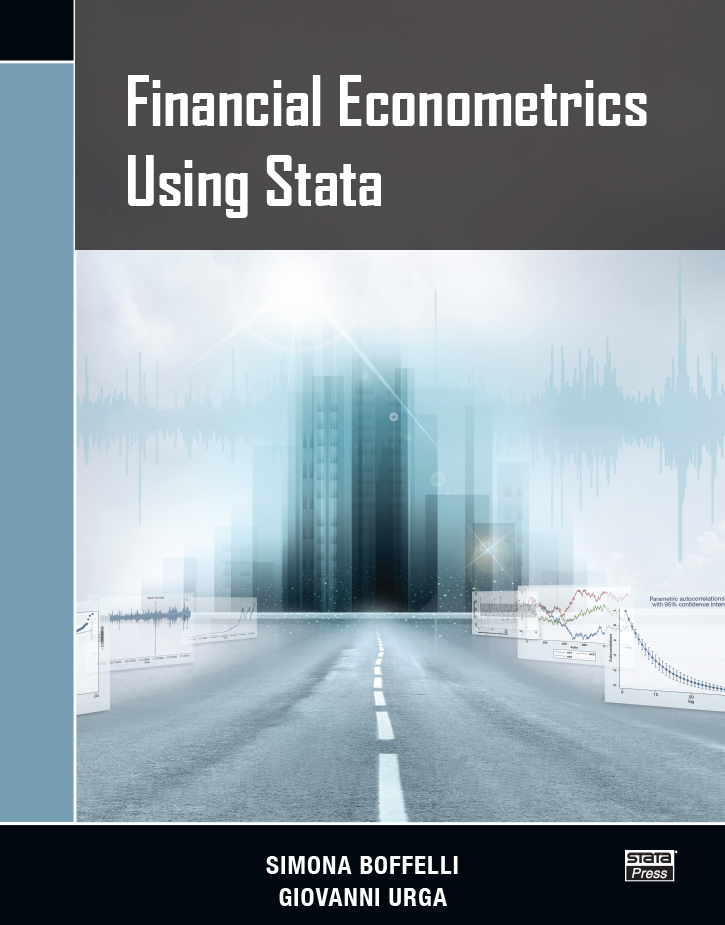Financial Econometrics Using Stata by Simona Boffelli and Giovanni Urga provides an excellent introduction to time-series analysis and how to do it in Stata for financial economists. Aimed at researchers, graduate students, and industry practitioners, this book introduces readers to widely used methods, shows them how to perform these methods in Stata, and illustrates how to interpret the results.
After providing an intuitive introduction to time-series analysis and the ubiquitous autoregressive moving average (ARMA) model, the authors carefully cover univariate and multivariate models for volatilities. Chapters on risk management and analyzing contagion show how to define, estimate, interpret, and perform inference on essential measures of risk and contagion.
The authors illustrate every topic with easily replicable Stata examples and explain how to interpret the results from these examples.
The authors have a unique blend of academic and industry training and experience. This training produced a practical and thorough approach to each of the addressed topics.
List of figures
Preface
Notation and typography
1.INTRODUCTION TO FINANCIAL TIME SERIES
The object of interest
Approaching the dataset
Normality
Stationarity
Stationarity tests
Autocorrelation
ACF
PACF
Heteroskedasticity
Linear time series
Model selection
How to import data
2. ARMA MODELS
Autoregressive (AR) processes
AR(1)
AR(p)
Moving-average (MA) processes
MA(1)
MA(q)
Invertibility
Autoregressive moving-average (ARMA) processes
ARMA(1,1)
ARMA(p,q)
ARIMA
ARMAX
Application of ARMA models
Model estimation
Postestimation
Adding a dummy variable
Forecasting
3.MODELING VOLATILITIES, ARCH MODELS, AND GARCH MODELS
Introduction
ARCH models
General options
ARCH
Distribution
Additional options
ARIMA
The het() option
The maximize_options options
Postestimation
ARCH(p)
GARCH models
GARCH(p,q)
GARCH in mean
Forecasting
Asymmetric GARCH models
SAARCH
TGARCH
GJR–GARCH
APARCH
News impact curve
Forecasting comparison
Alternative GARCH models
PARCH
NGARCH
NGARCHK
4. MULTIVARIATE GARCH MODELS
Introduction
Multivariate GARCH
Direct generalizations of the univariate GARCH model of Bollerslev
Vech model
Diagonal vech model
BEKK model
Empirical application
Data description
Dvech model
Nonlinear combination of univariate GARCH—common features
Constant conditional correlation (CCC) GARCH
Empirical application
Dynamic conditional correlation (DCC) model
Dynamic conditional correlation Engle (DCCE) model
Empirical application
Dynamic conditional correlation Tse and Tsui (DCCT)
Prediction
Final remarks
5. RISK MANAGEMENT
Introduction
Loss
Risk measures
VaR
VaR estimation
Parametric approach
Historical simulation
Monte Carlo simulation
Expected shortfall
Backtesting procedures
Unilevel VaR tests
The unconditional coverage test
The independence test
The conditional coverage test
The duration tests
6.CONTAGION ANALYSIS
Introduction
Contagion measurement
Cross-market correlation coefficients
Empirical exercise
ARCH and GARCH models
Empirical exercise
Markov switching
Higher moments contagion
Empirical exercise
Glossary of acronyms
References


